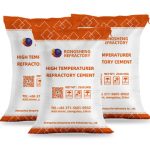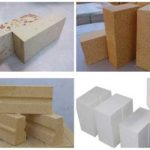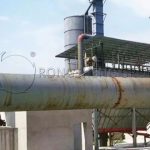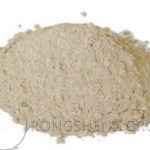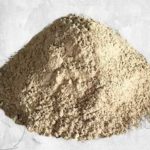As we all know, aluminate cement is often yellow or brown, and also gray. It is a hydraulic cementitious material made of bauxite and limestone as raw materials, calcined to produce clinker with calcium aluminate as the main component and about 50% alumina content, and then ground. Rongsheng refractory material manufacturer is an experienced refractory material manufacturer, and we can get an aluminate cement quotation for free.
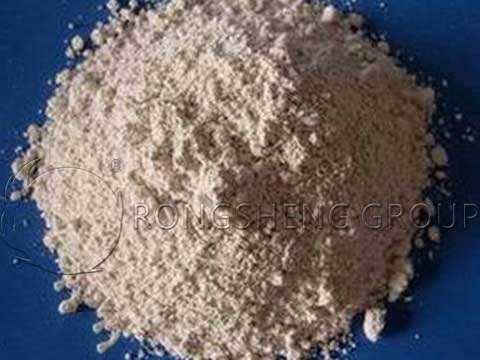
Mineral Composition of Aluminate Cement
In the CaO-Al2O3 system, C12A7, CA, and CA2 are the main minerals in aluminate cement. Table 1 lists the characteristics of these minerals. It is not difficult to see that C12A7 is a mineral with a very fast hydration rate, and a small amount exists in aluminate cement. It can promote the hardening of cement, but if it exceeds a certain amount, the cement will set quickly, the workability will be worse, and the strength will decrease. In production, C12A7 may appear if the calcination is insufficient. CA minerals not only have high strength but also have relatively normal setting time, moderate melting point, and good fluidity value. Therefore it is the main mineral in aluminate cement. The CA2 mineral is a mineral with a slow hydration rate, with long setting time and lower strength than the CA mineral, but the later strength increases. Therefore, in order to obtain high-strength cement, the ratio of CA and CA2 needs to be appropriately selected.
Table 1: The basic properties of several aluminate minerals
| mineral | Melting Point ℃ | Initial Setting h: min | Final Setting h: min | Fluidity mm | Compressive Strength MPa |
| C12A7 | 1420 | 0:05 | 0:07 | 180 | 15.0 |
| CA | 1600 | 7:00 | 8:00 | 260 | 60.0 |
| CA2 | 1750 | 18:00 | 20:00 | 260 | 25.0 |
The Working Principle of Aluminate Cement
Hydration of aluminate cement
According to Rongsheng Refractory Manufacturer, one of the experienced refractory material production and sales manufacturers, the hydration of aluminate cement is generally carried out in the following form:

Within 20℃, CAH10 is mainly formed. Above 21℃, it will transform into C2AH8 and C3AH6. Many researchers have confirmed that CAH10 and C2AH8 are metastable hydrates, which will eventually change to C3AH6. C3AH6 is the stable hydrate in the CaO-Al2O3-H2O system. It should be pointed out that due to the characteristics of the above-mentioned hydrates, the strength of concrete made of aluminate cement decreases with the passage of time and temperature changes.
The influence of alkali on aluminate cement
The effect of alkali carbonate and hydrated calcium aluminate in aluminate cement is carried out according to the following equation:
K2CO3+CaO·A12O3·ag→CaCO3+K2O·A12O3
2K2CO3+2CaO·A12O3·ag→2CaCO3+K2O·A12O3+2KOH
3K2CO3+3CaO·A12O3·ag→3CaCO3+K2O·A12O3+3KOH
The reaction product KOH in the above equation reacts with CO2 in the atmosphere to regenerate alkali carbonate, and alkali carbonate reacts with calcium aluminate hydrate again. This reaction keeps going back and forth, the calcium aluminate hydrate will continue to decompose, and the hydrated hardened body of aluminate cement will gradually be disintegrated. In other words, due to the presence of alkali, it can be used as a medium to promote the erosion of aluminate cement hydration products by CO2 in the atmosphere.
In the actual use of aluminate cement, the above reaction will often occur. Gradually sand and fall off on the surface of the hardened castable, this phenomenon is more likely to occur in summer. Some low cement castables use sodium tripolyphosphate as a dispersant, sometimes the surface grows hair first, and then there is sanding and sparseness. In fact, this is all caused by the above reasons. Aluminate cement is easier to form C3AH6 or C2AH8 in summer. When the aggregate used contains soluble R2O, this soluble R2O will migrate to the water molecules in the capillary pores. The surface then reacts with CO2 in the air to form alkali carbonate. Then according to the above chemical reaction, the calcium aluminate hydrate is decomposed and the hardened body collapses. When sodium tripolyphosphate is used as a dispersant, its alkalinity is relatively large, and NaOH will be formed during hydrolysis and migrate to the surface along with the pores. A similar phenomenon will also occur under the action of atmospheric CO2.

Varieties of Aluminate Cements
According to new standards for high alumina cement, it is divided into several types based on the content of Al2O3.
(3) CA-50
In fact, the high-alumina cement produced from natural bauxite on the market is also called bauxite cement, 50%≤w(Al2O3)<60%. According to the strength, it is divided into CA50-Ⅰ, CA50-Ⅱ, CA50-Ⅲ, CA50-Ⅳ, and the strength increases sequentially.
(3) CA-60
60%≤w(Al2O3)<68%. According to the main mineral composition, it is divided into CA60-Ⅰ(CA) and CA60-Ⅱ(CA2).
(3) CA-70
It belongs to pure calcium aluminate cement, 68%≤w(Al2O3)<77%. It uses industrial A12O3 as raw material, so there are few impurities and good gelling properties. It is suitable for the preparation of high-performance low cement or ultra-low cement castables.
(4) CA-80
It belongs to pure calcium aluminate cement, w(Al2O3)≥77%. Its main components are CA, CA2, and a considerable amount of α-A12O3 powder. It can be used to prepare refractory castables without or less other micro powder, and obtain the characteristics of no drop in strength at medium temperature. It is widely used to formulate high-performance castables.
Strength of Aluminate Cement
| Items | Cold Crushing Strength | Bending Strength | |||||||
| 6h | 1d | 3d | 28d | 6h | 1d | 3d | 28d | ||
| CA50 | Ⅰ | ≥20 | ≥40 | ≥50 | – | ≥3 | ≥5.5 | ≥6.5 | – |
| Ⅱ | ≥50 | ≥60 | – | ≥6.5 | ≥7.5 | – | |||
| Ⅲ | ≥60 | ≥70 | – | ≥7.5 | ≥8.5 | – | |||
| Ⅳ | ≥70 | ≥80 | – | ≥8.5 | ≥9.5 | – | |||
| CA60 | Ⅰ | – | ≥65 | ≥85 | – | – | ≥7.0 | ≥10.0 | – |
| Ⅱ | – | ≥20 | ≥45 | ≥85 | – | ≥2.5 | ≥5.0 | ≥10.0 | |
| CA70 | – | ≥30 | ≥40 | – | – | ≥5.0 | ≥6.0 | – | |
| CA80 | – | ≥25 | ≥30 | – | – | ≥4.0 | ≥5.0 | – | |
Problems in the Actual Application of Aluminate Cements
- In the actual use of aluminate cement, due to the influence of alkali on aluminate cement, it is strictly forbidden to use aggregates containing soluble alkali or additives containing R2O with high alkalinity. In order to avoid the phenomenon that the castable surface has hairy, sanding, and thinning. Especially in summer, this phenomenon is more likely to occur.
- In order to adjust the working characteristics of aluminate cement, a small number of surface-active substances, such as ultrafine powder, can be added to improve the fluidity of the castable. Reduce water consumption and add accelerator or retarder to adjust the hardening time of aluminate cement.
- When using CA-80 cement to prepare castables, try not to use (or useless) other fine powder. Because CA-80 cement already contains a considerable amount of Al2O3 fine powder. When too much powder is added, it will cause the castable to burst. When it must be used, an explosion-proof agent can be added appropriately.
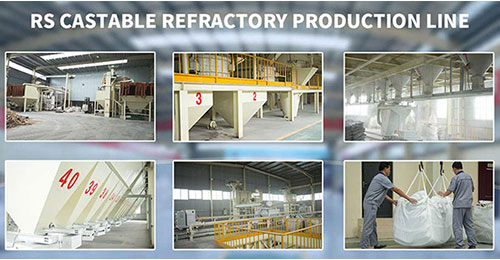
Rongsheng Refractory Manufacturer
Rongsheng is an experienced refractory manufacturer. Rongsheng’s refractory products have been recognized by customers in more than 60 countries around the world. For example, India, Pakistan, Kuwait, South Africa, Malaysia, Vietnam, Netherlands, Philippines, Singapore, Egypt, Russia, etc. Rongsheng’s refractory brick products and monolithic refractories, such as high alumina castables, wear-resistant castables, high-strength wear-resistant castables, refractory cement, aluminate cement, and other refractory materials have obtained product quality certification. Get the price of kiln refractory materials for free.
Leave Your Requirements on RS Kiln Refractory Bricks And Castable Materials! We Will Reply You In 12 Hours!:

